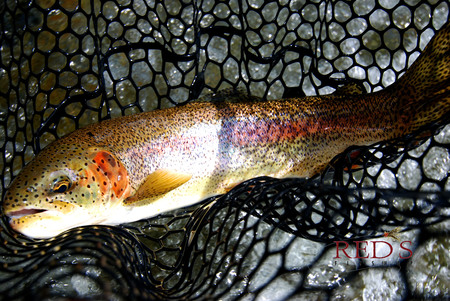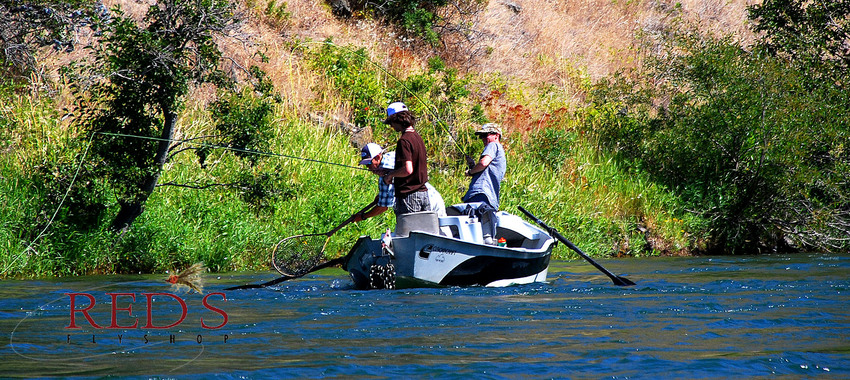Big Flows and Big Bows
July 11, 2014
Normal summertime river flows for the Yakima are big, and holding the boat in position is definitely "varsity" level rowing. The currents can be very pushy which makes holding the boat in a favorable position tricky. Having an experienced boat-man can make all the difference, so if have ever thought about treating yourself to a guided trip this is the time to do it. The fishing can be incredible and having a pro on the oars for 15 miles straight is one way to do it.
There is not another river that flows quite like the Yakima during the summertime. It runs swift even through the hottest part of summer making for incredible dry fly fishing, but it can require some very technical casting. It presents a worthy challenge and a wonderful game of marksmanship with a dry fly that we absolutely love. Even if you aren't super skilled, let us tighten up your game and show you some tricks to obtain great accuracy. Anglers that can consistently place a big dry fly tight to the bank will have some of the greatest days of fly fishing they have ever seen in the next 2 months here.
The Summer Stonefly on the Yakima River
The Unique Flow Pattern of the Yakima River
To summarize the Yakima?s unique flow patterns, it runs bank-to-bank in July and August to meet demand for irrigation downstream. The river stays high and relatively cool all summer while many other rivers get warm and low! This keeps the fish very strong and healthy all summer. It also makes for an endless supply of riparian habitat along the shore in which fish can hide, feed, and weather out the mid-day heat in privacy. Since the big flows move the fish right up against the shore, the trout are presented with ample opportunities to feed on grasshoppers, stoneflies, adult caddis, and many terrestrial insects that call the river banks home. Although the flows are big it makes for fabulous dry fly opportunities all summer long!
Big Flows = Big Bows
We rarely handle trout period, but in July ? September because of the summer heat and fishing pressure it would be just plain irresponsible to take a picture of every big trout our client's catch. Hopefully this ?eco-friendly? shot of a big Yakima Canyon Rainbow will inspire you to do this same. Take pride in a no impact release! This fish was released with minimal impact and is waiting for you to cast a fly at it!
Taming the Beast... called the Yakima Canyon
Taming these big flows can be tough but they are the very reason we have fat healthy Rainbow trout here in the Yakima Canyon. July and August are our busiest months on the Yakima River for good reason ? the dry fly fishing can be silly at times! The best trip we have going for sheer value is our Twilight Highlight package, it is a "low light" dry fly oriented trip for the serious angler.
Fishing Tips:
First off, get a good rower to maximize your efficiency. Plain and simple advice. The rower is like the point guard that moves the ball up the floor, divides the lane, and sets up the easy pick ?n roll layups. There is a world of difference between the boat owner that gets out a few days a year and a pro guide this time of year. No offense to the DIY boaters, there are lots of expert oarsman that aren't guides, just make sure that the team plays to its strengths? the rower rows and the fisherman fishes. Guides will work hard to keep that boat lined up on the very best seams all day long. We are getting paid to do this so you can trust we work very hard at it.
Second, the tempo of casting, mending, and recasting is very quick. Rivers like the Yakima are exactly where and why fast action fly rods were birthed. There is a lot of short, fast shots tight to the bank line that require a very quick pickup and lay down with a tight loop to get under brush and up against the shoreline.
Third, learn to presentation cast. Subtle reach casts that build some mending slack into the drift are VERY helpful for keeping your fly in the softer seams along the bank. The number one tip that we can give you is to STOP THE ROD HIGH! This builds a bit of slack into the cast so that once the rod is lowered you can mend the slack without jeopardizing that sweet position your fly landed in a couple of inches from the cutbank! Eventually after you master that high stopping point on the forward cast you will learn to manipulate the slack into a mended position so that the fly will stay along the shore and hold that current line for several seconds. After this? repeat, repeat, repeat. Lots of good drifts along the bank of the Yakima Canyon will yield some fabulous trout.
Fourth, keep your wits about you and fish within your means. Whomever said ?you are fishing hard enough if you aren?t losing flies was not a very good caster!? was not a very good fisherman. Fish conservatively and it is better if your fly lands a few inches or feet short of the bank than a few inches or a few feet up onto the bank! Easy to say that here and now from inside the fly shop but please consider this. Smart casters place flies in current lines that ?draw? the fly towards the shore. We also aim for gaps, coves, and alleys in the sticks that are not high risk shots. Fish smart.
Fifth, fish midweek and early or late. Weekends in the Yakima River Canyon are dominated by inner tubers and river rafters. Don?t expect them to share the environment the way you do, it just won?t happen! Give them their time mid day during the heat and fish the evenings and early morning hours.
Lastly, the Yakima River is an incredible summer experience for hopper fishing and dry fly fishing. Its big current offers luscious riparian habitat along the shore that is unrivaled by any western river. The river flow provides 19 miles of straight hopper and stonefly habitat in the Yakima Canyon. Imagine a float where every single cast is being tossed up against a beautiful cutbank. Hundreds upon hundreds of opportunities to cast hoppers at cutbanks every single drift!
![Reds Fly Shop [logo]](/img/reds-fly-shop/logo.png)
